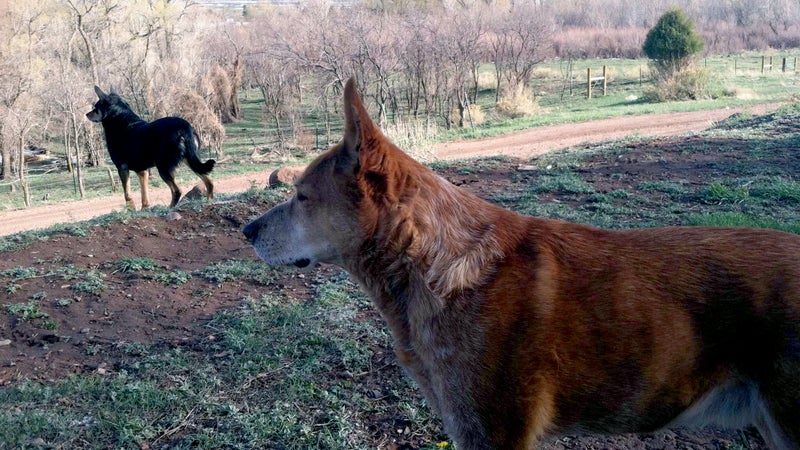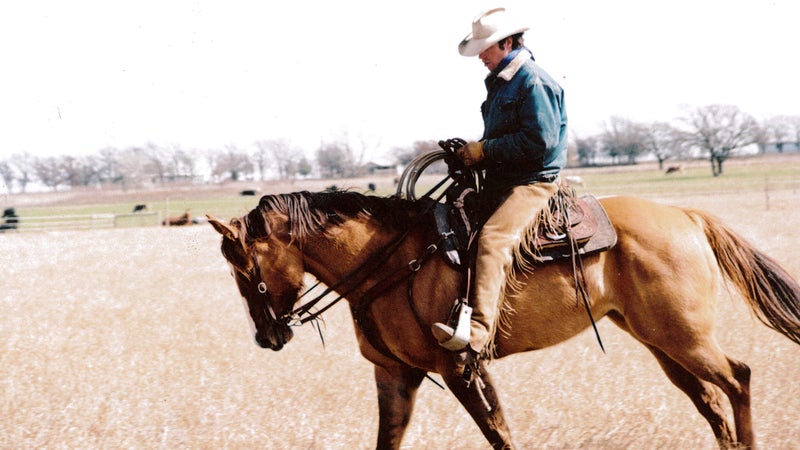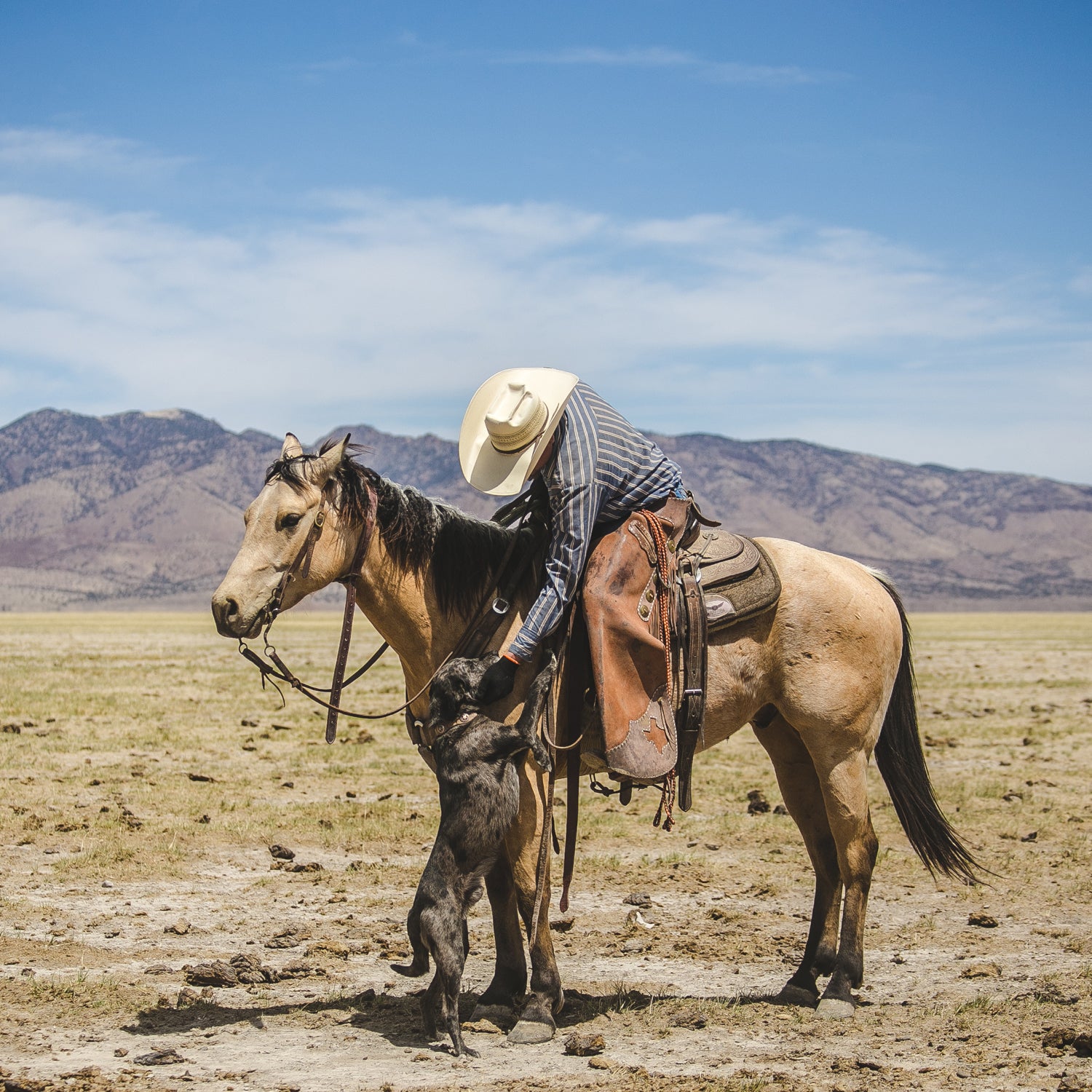When I lived on a small ranch in Texas, I raised an all-star pair of ranch dogs named Jenny and Reddy. They were the same height—standing to below my knee—both 40 pounds, fit and trim, and worked together flawlessly.
Jenny was an Australian kelpie, a smooth-coated collie with brown points like a Doberman pinscher. I imported her to Colorado from Australia in 2003. I’d been in the country traveling and working on a few sheepherding operations—called stations—after college, and nearly every outfit I rode for had a couple kelpies in the yard. I began to take notice of the dogs and liked what I saw. I told one old-timer with two kelpies and a clutch of sheep grazing the highway shoulder that I’d never heard of the breed before coming to Australia. He cocked his head and asked, “Well, whad’ya do for dogs?”
After a few months of watching the dogs funnel sheep into corrals, muster cattle off shale hills, and balance on dirt bikes, I thought I could do with a kelpie for a dog. A young woman on a station in Tambar Springs, New South Wales, said she could fix me up if I’d be willing to send her a few pairs of Wrangler jeans when I returned to the States. Not a problem, I told her, and two weeks later paid $400 for a little black-and-tan pup with floppy ears and glassy eyes. She was the last pup of her litter; the others had been bought before birth and were headed to working lives on stations.
Like my good friend who ran a farm in Northern California once told me, “They say farm dogs and baby elephants are the happiest critters on earth.”
“Mate, you owe me for this one,” said the young woman. “She’ll be a bloody good dog for you.”
Jenny landed with me on a ranch in Larkspur, Colorado, where I was breaking horses. To teach her the herding commands, I bought her six Muscovy ducks. The first afternoon, we had a duck rodeo as I clipped their wings. It was Jenny’s introduction to controlling other animals.
In 2004, I leased a ranch in North Texas to run a horse training operation. I arrived in the teeth of summer. The place hadn’t been worked in years. The temperature beat 100 degrees, and the weeds in the corrals stood six feet tall. I’d been hired to break three stallion colts, but other than them and the owls and snakes, the place was empty. Too empty for Jenny. She wouldn’t eat. She was depressed. A month prior, I’d quit a horse job at a fancy ranch near Dallas before starting my own outfit, and Jenny missed the flow of ranch visitors and the salmon leftovers that city-side women brought her.

There was nothing to do but get another dog. My ranch hand, Myra, and I went down to the pound, where we picked out a Queensland heeler with massive ears. The bald man wearing elbow-length rubber gloves that we spoke to implied that we’d interrupted him “putting down in the back.”
“How long are they here before you kill them,” asked Myra, who grew up in West Texas and was as tough as a rattlesnake.
“About two weeks,” said the man.
“How long’s this one been here?” I asked as the dog pressed against my leg. He smelled like the floor drain of a kennel and looked like he was carrying a load of parasites. Big damn ears, though.
“About two weeks,” he said.
That’s how Reddy came aboard.
Reddy came home with me, and Jenny started eating. They fell in with each other like two burning houses and hardly spent a day apart from then on. Jenny was the brain, and Reddy was the brawn. He suffered more injuries, was yelled at more often by me, and generally had a rougher go of life. But like my good friend who ran a farm in Northern California once told me, “They say farm dogs and baby elephants are the happiest critters on earth.”
I can’t tell you what a baby elephant does for fun, but I can tell you what ranch dogs get into. They swim in water troughs all summer and sleep in front of fireplaces on winter evenings. They raise hell with barn cats and hunt gophers, rats, and anything else that’s interesting. They don’t see leashes very often, and they’ll run a mile before dawn. But what sets a ranch dog’s life apart from nearly every other dog, working or otherwise, is the constant interaction with the livestock.
Any ranch dog worth his feed has a keen sense of the stability and harmony of the operation’s livestock—the animals are either happy or upset, where we want them or out of place, doing exactly what we want or about to get roped by a cowboy. Jenny, being the more cognitive dog, was savvy enough to know if a horse was about to kick the stall door out of impatience for grain. Reddy had a harder time sensing the tension build, but once something happened, he brought the teeth.
The view from the front porch of my two-room cabin stretched three-quarters of a mile to the county road. The driveway, fenced on both sides, cut a wide arc along two pastures. On a late summer evening, after I’d had Reddy about six months, I watched an old blockheaded cow jump the fence for the ungrazed shoulders of the drive. The first time it happened, I pulled on my boots and spurs and loped my horse out to put her back where she belonged. After that, I could count on Reddy to handle it.
I’d watch the cattle meander to the end of the pasture, where the renegade cow couldn’t help herself but to find the low spot in the fence. When she’d start her beeline, I’d tell Reddy that his old pal was back at it. He’d stand from the dusty hole he slept in and look to the pasture. Once she made her jump, Reddy would be off like a shot, and all you could see of him as he shortcut through the hay meadow was his red tail skimming through the tall grass.
Reddy came in hot on the cow, blowing past her on the initial in-run. He’d circle back, grabbing her heels and then her nose. She’d turn in fighting circles, never quite able to connect with him. Jenny would join in but always left the real work to Reddy. She’d swing wide around the pair, crouching, sprinting, barking. When Reddy became too much of a hassle for the cow, she’d jump back over the fence, and Reddy would detour by the pond for a swim and drink before resuming his nap.
The most useful command I taught my dogs besides “come” was “watch out.” Usually it meant get of my way. Occasionally it meant you’re too close to my horse, or I’m about to lay this tree down with a back cut, so get the hell out of here. Being able to create space between the dogs and whatever I was doing kept them safer and minimized their unwanted involvement in most jobs. I never needed their help changing a tire or a leg bandage on a horse, and they knew they were less likely to get a curry comb thrown at them if they kept their distance.
People would tell me that Jenny and Reddy spoke English. I’ve heard the same said about other dogs, and mostly what it means to me is that the dogs respond to tone of voice—it doesn’t really matter what you say so much as what you mean. I could tell the dogs, “Go inside the house,” and they would. Or I could say, “Get your sons-a-bitching asses inside that cabin or I’ll tie up you both for a week,” and they’d go inside the house.

A ranch dog’s sensitivity to tone and direction develops from the constant, everyday handling. Barring an injury, which would happen every six months or so, the dogs spend all day, every day with you. It’s a working relationship. The smart ones will be better company and harder workers than a hired man—and drink less alcohol and tear up fewer pickups. The dogs complement the workplace. They’re part of the ranch, and the ranch is part of them.
When I closed the horse training operation in 2008, the dogs were insufferable. They glared at me from under the big oak tree as I cleaned out the tack room. They sat motionless in the barnyard, bleeding out a soft whimper. They had little interest in their food. They knew it was all coming to an end—riding out at a fast trot before dawn, sleeping in the cool grass by the pond, treeing barn cats on slow days—but they didn’t know that it would mean the end of their working lives.
As soon as we left the ranch for journalism school at the University of Montana, the dogs’ health began to decline. Jenny had a tumorous mammary removed that fall. Reddy developed a wheezing condition that came on at night and left him breathless. They gained weight. I fed them only in the evening because they had no use for the calories. Sure, they treed a bear in Montana and chased cows in southern Colorado, but they weren’t working.
In 2012, I paid $5,000 to have a tumor removed from Jenny’s spleen. Two days later, she died in my backyard. A month later, Reddy died, just before Christmas. A cancerous mass had effectively closed his esophagus, and I called an at-home death service to send him off. On the heels of a brandy hangover, I got the flu. For a week, I could hardly build a sentence from my stale, sweat-grimed bedsheets.
On December 31, I emerged from the worst sickness I could remember. I called a border collie breeder in northern Colorado and asked after his pup situation. He told me he had a litter ready to go to new homes as of a week ago. I hung up and went to buy another dog.
The border collie, Danny, is now two years old. We live on a postage-stamp horse property outside Santa Fe, New Mexico, and though I spend most of the day at the laptop, Danny and I have chores to keep us busy, at least in the morning. It’s hard to call it a working life, but it’s ranch life. And that should keep him happy.


